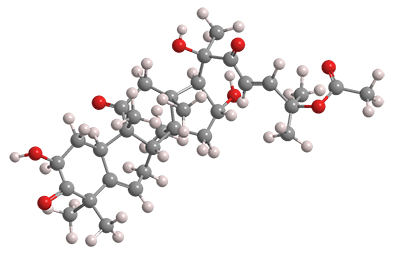What molecules are we?


Cucurbitacins are tetracyclic terpenes with steroidal structures that are isolated from plants of the family Cucurbitaceae such as pumpkins, gourds, and cucumbers. Ancient peoples used cucurbits medicinally, but they also recognized their toxic properties. Medicinal uses included emetics, narcotics, and antimalarials.
Twenty cucurbitacins have been isolated from the ≈965 known species (in ≈95 genera) of Cucurbitaceae. By the 1950s, the research groups of P. R. Enslin (South African Council for Scientific and Industrial Research, Pretoria) and David Lavie (Weizmann Institute of Science, Rehovot, Israel) had isolated 17 cucurbitacins and studied their properties. Lavie’s group showed that cucurbitacin E (also called α-elaterin) has antitumor properties.
The two most common cucurbitacins are B and E. Cucurbitacin B, whose structure is shown, is extremely toxic when ingested (see hazard information box); E is not as toxic but is still harmful if swallowed.
Cucurbitacins are also known as “bitter principles” of cucurbits. In a recent article, Logan Kistler at the University of Warwick (Coventry, UK), George H. Perry at Penn State (University Park), and colleagues at several other institutions reported that, despite the fruits' bitter taste, prehistoric animals such as mastodons and mammoths ate wild cucurbits and distributed their seeds in their excrement. As the ancient beasts died out, the cucurbits also faded because their primary means of seed dispersal was gone.
Humans came to the rescue. They found that they could eat cucurbit seeds, probably by washing off the bitter constituents. Later, they domesticated squashes and gourds and, by selecting the less bitter seeds, were able to produce more palatable cucurbits. Thus, humans and cucurbits evolved together.
MOTW update
Xylitol was the Molecule of the Week for May 5, 2006. This sugar substitute continues to be popular, so much so that Fortress Global Enterprises (North Vancouver, BC) has announced that it will build a wood-derived xylitol plant at its newly acquired pulp mill in Thurso, QU.
Cucurbitacin B fast facts
| CAS Reg. No. | 6199-67-3 |
| Molar mass | 558.70 g/mol |
| Empirical formula | C32H46O8 |
| Appearance | White crystals |
| Melting point | 184–186 °C |
| Water solubility | Slight |
Cucurbitacin B hazard information
| GHS classification*: acute toxicity, oral, category 2 | |
| H300—Fatal if swallowed | |
*Globally Harmonized System of Classification and Labeling of Chemicals. Explanation of pictograms.

Learn more about this molecule from CAS, the most authoritative and comprehensive source for chemical information.
Molecule of the Week needs your suggestions!
If your favorite molecule is not in our archive, please send us a message. The molecule can be notable for its current or historical importance or for any quirky reason. Thank you!
Stay Ahead of the Chemistry Curve
Learn how ACS can help you stay ahead in the world of chemistry.

